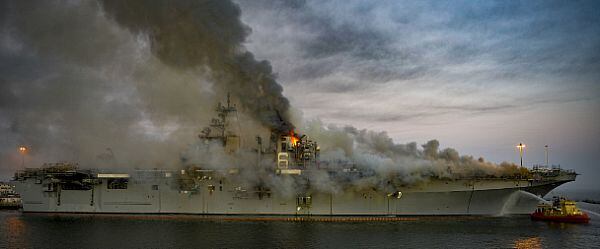As the fire aboard the amphibious assault ship Bonhomme Richard continues to rage in San Diego, all five personnel who were hospitalized due to injuries suffered while fighting the blaze have been released, according to the Navy.
In total, the Navy said 36 sailors and 23 civilians were treated for “minor injuries” such as heat exhaustion and smoke inhalation in the aftermath of the fire.
Sailors first reported the fire at about 8:30 a.m. PDT Sunday, and firefighting efforts to extinguish the blaze have continued since then. The Navy said at 11:30 p.m. on Monday crews from Helicopter Sea Combat Squadron 3 would continue to combat the fire through the night.
According to Rear Adm. Philip Sobeck, commander of Expeditionary Strike Group 3, the top objectives for firefighting efforts are ensuring the fire doesn’t reach the 1 million gallons of fuel on the ship, and preventing the vessel from listing.
The fire was first reported in a lower cargo area where seafaring tanks and landing craft are parked. It appears to have started in a spot where cardboard boxes, rags and other ship maintenance supplies were being stored, Sobeck said.
“There’s plastics that go around cabling, those kind of things, there’s different rags, there’s all the things that are used to kind of maintain the ship, clean the ship … and so right now we’re testing and we’re checking everything that we know, and we’re within (U.S. Environmental Protection Agency) standards,” Sobeck said.
The San Diego Air Pollution Control District warned that concentrations of fine particulate matter could reach unhealthful levels in some areas and that people should avoid exercising outdoors and stay indoors if possible to limit exposure.
RELATED

Meanwhile, Cmdr. Chris Wright, response department head of Coast Guard Sector San Diego, said the Coast Guard “continues to assess environmental sensitivities and has contracted an Oil Spill Response Organization to preemptively deploy a protective boom to guard against any potential environmental concerns.”
As a result, a one-nautical mile safety zone is in place to protect the maritime public, he said.
“Additionally, a one-nautical mile temporary flight-restriction zone from surface to 3,000 feet altitude has been established to maintain the safety of all firefighting aircraft,” Wright said in a statement. “Neighboring marinas are also currently being advised to utilize protective safety measures.”
“The safety of first responders, protection of the marine environment and the uninterrupted flow of commerce remain the highest concerns to the Coast Guard,” Wright said. “Responders will continue to monitor and assess potential environmental concerns and adjust response actions to ensure the safety and security of the maritime public and the marine environment.”
The Associated Press contributed to this report.



